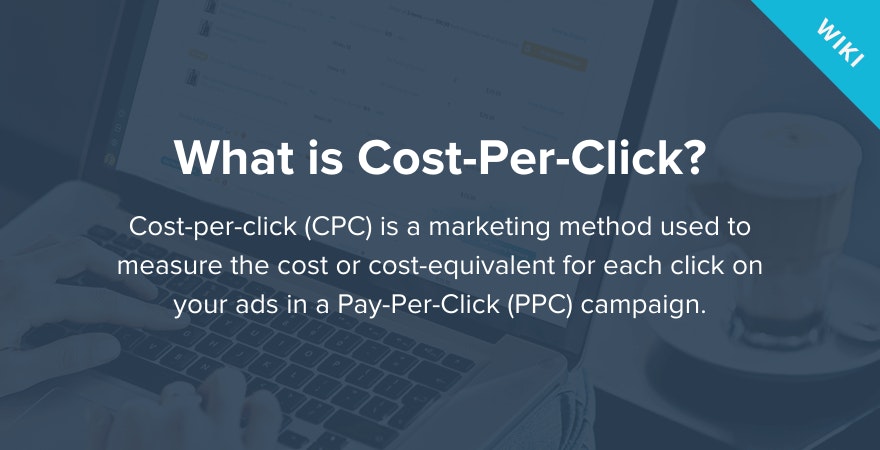
Cost-Per-Click (CPC)



What is Cost-Per-Click (CPC)?
Cost-per-click (CPC) is a digital marketing method used to measure the cost or cost-equivalent for each click on your ads in a Pay-Per-Click (PPC) campaign. It’s a metric that determines the success and return on investment of your paid search campaigns.
How is Cost-Per-Click (CPC) Calculated?
The formula used to calculate CPC is the cost to an advertiser divided by the number of clicks. For example, if an advertiser paid $150 for a campaign that received 42 clicks, the CPC would be $3.57 (150/42 = 3.571).
Evaluating the paid search campaign performance and return on investment can prove to be confusing, as different platforms use different attribution models to measure conversions.
→ Click Here to Launch Your Online Business with Shopify
For example, AdWords only focuses on the performance of your paid search efforts independent of other channels and attributes all conversions to paid ads, regardless of whether the interaction with a paid ad was the last touchpoint in the customer’s buying journey or not. If a customer clicks on a paid ad but doesn’t convert, then later returns to your website directly to complete the order, AdWords will attribute that conversion to the last click on a paid search ad. If a customer has several interactions with paid search ads, say with a Shopping ad first and then a Remarketing ad, the conversion credit will go to the last click (the Remarketing ad).
Google Analytics offers a wide range of attribution models that treat conversions differently. If your GA report is set to a default view of Last Non-Direct Click, every purchase that is made on the site will be attributed to the last channel a customer has interacted with before buying, excluding Direct. Be sure to study all attribution models to choose the one that ties in with your goals and gives you an accurate picture of all advertising efforts.
How to Optimize Cost-Per-Click?
Engineering a successful pay-per-click campaign is a challenging task, which requires a lot of fine-tuning and planning. The best way to optimize it is to work top-down on your account structure calibrating the three most important elements shared by all successful paid search campaigns:
- Campaigns can contain a number of different ad groups. For example, if you’re running a Black Friday Sales campaign, you’re able to create different ad groups for each of your products.
- Ad Groups help you stay organized. You should aim to create a separate ad group for every product you sell and then experiment with different ads for those products within a relevant ad group.
- Ads are the promotional messages shown to users.
AdWords is by far the biggest paid search advertising network, but it’s not the only option. Other highly popular networks are Bing, Facebook Ads, LinkedIn Ads, and Adroll.
Keywords (only relevant for AdWords campaigns). As a foundation of your pay-per-click campaign, keywords will be your primary concern. To avoid spending too much money competing with your competitors for the top spots for the most popular keywords, devote time to researching what words or phrases (long-tail keywords) your potential buyers are using to find your product/service. Use negative keywords and ensure your campaign is not built on broad match keywords to avoid attracting shoppers with the wrong intent.
Note that paid social media ads are not based on keywords. Demographic information and interests take the central stage in these campaigns.
Ad copy. To write a high-performing ad text copy, you must think about the three essential components: features, benefits, and a call to action. Consumers are searching online to solve problems, not to buy products or services, therefore focusing on the benefits first is key. But all three elements should be incorporated to increase the click-through rate. Other timeless tips for writing good copy include using active verbs, avoiding repetition, and experimenting with unconventional calls to action.
It is worth noting that social media ads are more image-based, so the click-through rate depends heavily on the visuals as well as catchy headlines and ad descriptions. And while the success of AdWords campaigns is hugely reliant on ad relevancy, social media campaigns thrive on invoking user curiosity. Highly converting copy is typically charged with humor and flair.
Landing page; You need purpose-built landing pages for your paid ad campaigns to maximize the percentage of visitors that convert. When designing a landing page, consider and optimize the most important elements:
Headline; look for a compelling headline that’s relevant to your ad copy and keywords, Brand-consistent design; aim for a clean and simple design that follows your brand guidelines and instils trust.
Copy; work on strong copy that concisely communicates the value of your offer.
Landing page form; build a user-friendly form that captures only the information you need
Button; experiment with eye-catching calls to action that compel visitors to act immediately.
Monitor your campaign’s results and continue tweaking the elements to achieve higher ROI.



Want to Learn More?
- 10 Actionable Tips From Proven Facebook Marketing Experts
- Anyone Can Advertise on Google AdWords and Here’s How
- Facebook Ads Tactics That’ll Skyrocket Sales!
- The Complete Guide To Marketing Channels
Is there anything else you’d like to know more about and wish was included in this article? Let us know!